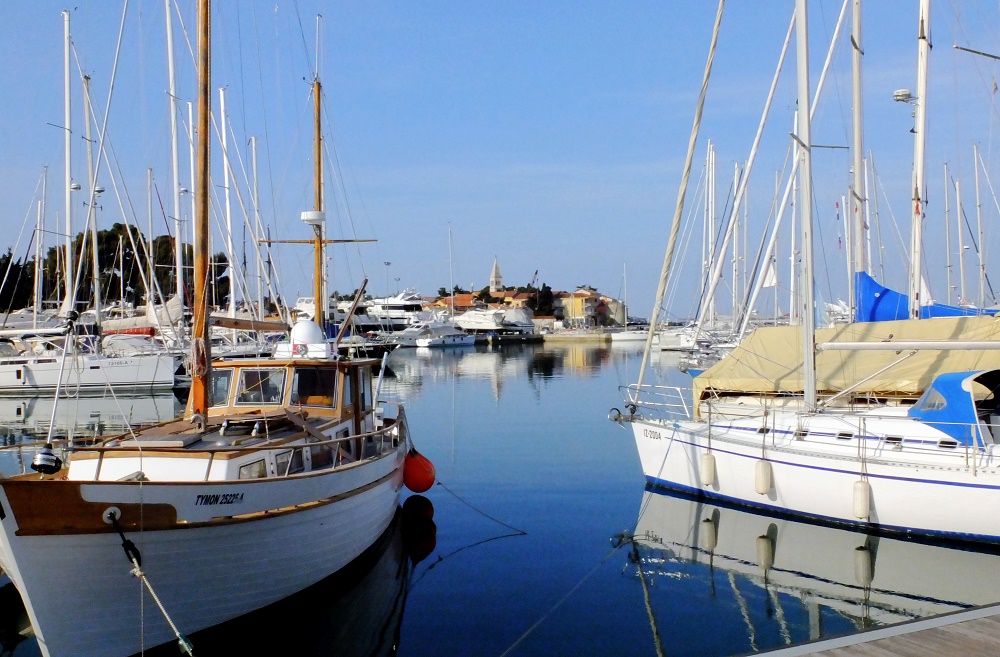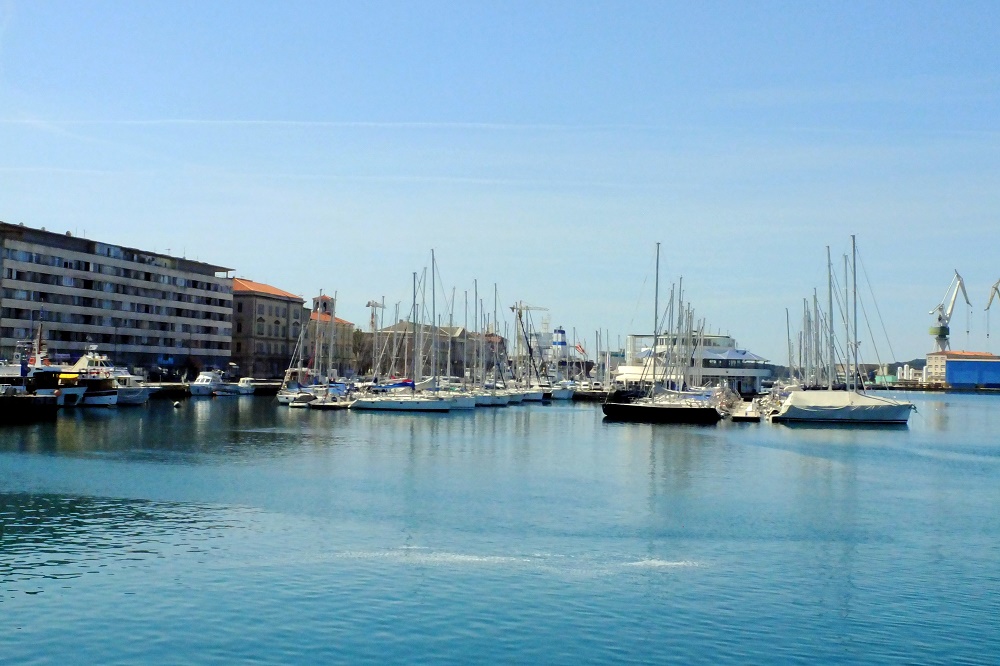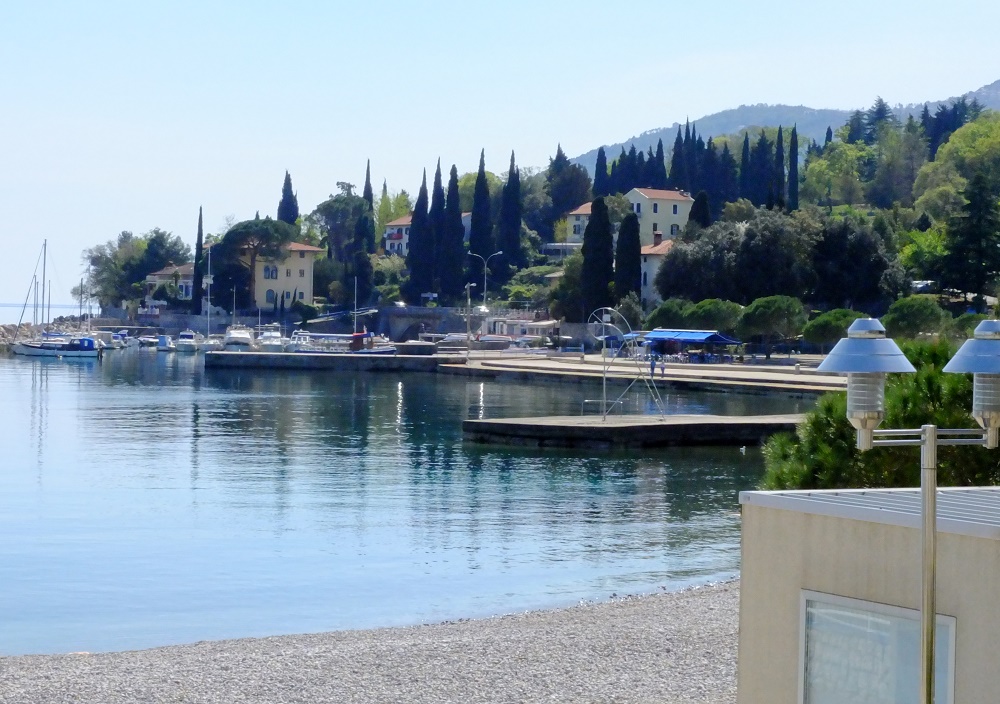Sailing around Istria – Umag, Novigrad, Porec and Rovinj

Meet the place
This heart-shaped piece of land is Central Europe’s closest coastline of the Mediterranean Sea stretching south from Triest until the lighthouse of Porer (the most southern point of the peninsula near Pula) and north from there until Rijeka in 445 kilometers. The Istrian coast – or Blue Istria as they call it lacks the appeal of out-of-the way sandy coves, which you will find on the Dalmatian islands. The charm of the Istrian seashore is the rocky coastline in which you can find ports in compact towns like Porec and Rovinj with small alleys grouped around medieval churches.
When to visit?
The cruising season opens on Easter but the peak season starts in mid-July when lot of Italian and german yachts invade the coast. During peak season it is often necessary to arrive early to find a berth, and you’ll need a back up plan in case your first choice is full. In the third week of August the visitors disappear just as quickly, leaving the area to the Germans and Austrians who have different holiday times than in southern european countries. All is quiet again through September and October.
Where to go?
If you have turned your boat’s rudder direction to Istria, your main ports of interest are Pula and Rovinj, but the first port coming from the north (direction Slovenia) is Umag, where you have to stop for a log in, if you are coming from international waters or another country. The big ACI marina is a recommended starting point for a yacht charter in Croatia. Further south, offering plenty of moorings in the newly developed marina is the town of Novigrad. Marina Laguna is also in Novigrad, but in the old harbour. There are several marinas around the picturesque town of Porec, including Marina Cervar-Porat to the north and Marinas Parentium and Funtana in the south – seven miles south of Novigrad.
After the small town of Vrsar, you will arrive to one of the most beautiful towns of the north Adriatic sea: Rovinj. Dropping your anchor in Rovinj and spend a few nights is more than expedient before heading to Pula. Located near the tip of the Istrian peninsula, Pula with it’s large harbour is Istria’s boating mecca. It’s ACI marina and the marinas of Veruda, Pomer and Medulin offers plenty of mooring opportunities for sailing enthusiasts. Pula’s 3000 years old town with it’s great Roman amphitheater is a must see for every sailor in the Adriatic together with the nearby islands of Brijuni.
Pula is also a great port to start your yacht charter tour, because you can either sail to the direction to the Kvarner Islands (Krk, Cres, Rab…) or sail along the East side of the Istrian coast which is a lot less crowded but offers great natural inlets that are ideal for overnight anchorings. Sailing around the peninsula and up to Rabac and Plomin Luka you will see why Croatia is known for its natural beauty. The beautiful hilly landscape extends up the coast to the popular and elegant resort of Opatija. The town boasts a good selection of hotels, dining choices and easy to access marinas.
The most important marinas:
Umag
Umag lies on the north-western coast of Istria. Here you will find beautiful hills providing magnificent scenery, crystal clear water, exciting history, agricultural specialties and friendly hosts. Looking for cultural attractions visit the Umag town walls, the Museum or the Savudrija lighthouse.
- POI # Kozlovic Winery, Momjan
The experience of the view from the terrace of the winery is amazing. Also the contemporary design of the cellar is fantastic with some of the best wines Croatia has to offer.
Novigrad
Novigrad Marina is on the West coast of Istria in a town with rich historical and cultural heritage and one of the top Istrian gourmet destinations. Visiting the place it is worth seeing the baroque Rigo Palace of Novigrad and the seaside promenade running along the coast to the Novigrad marina.
Porec
Marina Poreč is situated on the western coast of Istria. Walking in the streets of Poreč you can encounter the remains of the Roman sanctuary, Romanesque, Gothic and Baroque palaces. Those who are interested in active recreation can try carting, paintball, waterskiing, jet-skiing and mountain biking. Happy Charter Porec offers power boats to rent at the marina.
Cervar. Porat is located 6 km north from Poreč, a small coastal town. The beach is 1,5 km long and the sea is crystal clear. Ideal for for a family vacation because of the pines, rich vegetation and safe beaches. You can find cycling paths from Červar to Poreč and several tennis courts too in town.
- POI# Euphrasias Basilica in Porec
Wait until 4 p.m. to see for free the wonderful medieval mosaics and wall frescoes of this early Byzantine church.
ACI Marina Rovinj

ACI Marina Rovinj is located in the South-Eastern part of the harbour only 1 km away from the centre. Visiting Rovinj it is worth seeing the old city center, the beautiful Forest Park Punta Corrente or the Church of St. Euphemia.
- POI # Old Town in Rovinj
Infinite walks on the narrow alleys of the old town showing the unmistakable signs of Venetian heritage. - POI# Port of Rovinj
Lovely bars and cafes in the port where lots of boats dance on the water. - POI # Saint Euphemia Cathedral in Rovinj
Can’t miss the cathedral when walking around in Rovinj. It is a sight to see from above.
Pula
Pula is situated on the southern part of the Istrian peninsula. The city has many historical sights, among them the most popular is the Roman amphitheatre. Approxiamately 1 km south of Pula there is the Verudela Peninsula, where 190 kilometres of mixed beaches can be found.
- POI# Amphitheater in Pula
This is one of the largest and oldest Roman arenas in Europe, don’t miss to visit it, once you are in town! - POI# Triumphal Arch of Sergius in Pula
A more than 2000 years old Roman arch on the main shopping street of the town. - POI# Temple of Augustus, Pula
After you visited the Roman city walls as you walked from the waterfront, it is worth to stop by this small Roman temple almost preserved intactly, hit by a grenade during the war, but reconstructed afterwards. - POI# National Park Brijuni
The Brijuni (Brioni) Islands off the shores of Pula are a very nice national park which you can visit by boat and where you can make a round the island trip by bike which you can rent.
ACI Marina Opatija (Icici)
ACI Marina Opatija is situated in the town of Ičići. The town has large partly sandy beach by the centre. The famous coastal walk, the Lungomare can be found in Icici. Concerning sports activities, you can choose from tennis, volleyball, football, badminton, water polo, hiking and cycling.
Tips for sailing trips
7day-trips
1. Pula-Pomer-Opatija-Punat-Koljun: From Pula you can sail to the small and tranquil village of Pomer. On day 3 sail onwards to Rabac and be sure to stop for some fresh seafood. On day 4 sail to Opatija, passing numerous quaint villages with their old villas and summer waterfront residences. Day 5 cross over to Punat and spend your last days visiting the sites such as the Franciscan monastery on the island of Koljun.
2. Rovinj-Pomer-Pula-Novigrad-Porec-Rovinj: For another 7 day relaxed sailing trip you can start from Rovinj. On day 2 cruise to the bay of Pomer where the reefs and shoals have excellent snorkeling. On day 3 you can visit the beautiful old town of Pula then sail northwards to the small town of Novigrad. Stop to dine here at excellent fish restaurants and on day 5 head to Porec and set sail for your return to Rovinj on day 6.
3. Veruda Bay-Susak-Premuda-Mali Losinj-Pomer-Rovinj: A different sailing itinerary from Rovinj for 7 days is beginning your yacht charter in Veruda Bay. On day 2 sail over to Susak Island. After swimming at the sandy beaches here, sail on day 3 to Premuda. On day 4 visit the bustling town of Mali Losinj and on day 5 sail back to mainland to Pomer before returning to Rovinj on day 6.”
Useful information before leaving
The weather
This area of the Adriatic Sea is not far from the predominant North and Central European weather systems.
- Bad weather: When a cold front approaches from the west this usually means South/South-East winds starting light and, over 2/3 days, gradually increasing, veering and finally going North West as the front goes through. The process often finishes with a North East bora wind reinforced by the mountainous coast. Periods of thunderstorms are quite common in the northern Adriatic, and can be particularly violent, generating tornados where (for brief periods) winds may reach 40kts, and reverse direction in a matter of minutes as the tornado passes through.
- Predominant wind, the Bora: very strong, cold Northeasterly wind from the mountains from Croatia and Trieste. It could be a a seriuos threat to navigation but in summer there is very little chance of Bora winds. During winter there is a bigger chance for a Bora that usually lasts 12 hours, maybe 2 days with local gusts up to 40, 60 knots. For more on the Bora, visit Weather Online http://www.weatheronline.co.uk/reports/wind/The-Bora.htm
Good weather: during the summer months it is a general consensus that the Adriatic is a light wind area. Sea breezes may reach a Beaufort5 in the afternoon that drops by night. Land breezes my develop lighter (Beaufort3) in the morning. - Predominant wind, the Jugo: Southeasterly, warm wind. It blows across the Adriatic when a cyclone develops over the Adriatic area. It brings clouds and rain. The air pressure drops. It develops slowly and it can usually be noticed two or three days in advance. It usually lasts longer than Bora, five to seven days, and even longer in winter. There is a possibility of the so called dry Jugo, when it blows for a couple of days without bringing rain. Unlike Bora, Jugo is a constant wind that gradually gains strength.
- The Mistral: Mistral is a “benevolent”, a friendly wind looked forward by especially sailors and all those who enjoy the summer season under its breeze. Mistral is a daily wind blowing from the northwest and created by the differences in temperature between the mainland and sea. It is fairly frequent from spring to autumn and strongest in July and August. It usually starts blowing around 9 or 10 in the morning, reaches its highest strength in the afternoon and fades at sunset. Mistral is generally weaker in the north Adriatic than in its south.
For detailed forecasts you should take into consideration that the nearby islands adiacent to the coastline will modify the winds: winds resulting from frontal systems and pressure differentials are likely to be as predicted when more than twenty miles off the Dalmatian coast, close to the land and amongst islands the wind conditions may vary widely from the forecast.
Avarage wind conditions from Windfinder for Pula http://www.windfinder.com/windstatistics/pula
June: dominant wind dir: E; average wind speed: 4 kts; ave temp: 25 C
July: dominant wind dir: NW; average wind speed: 3 kts; ave temp: 30 C
August: dominant wind dir: W; average wind speed: 4 kts; ave temp: 28 C
Summer temperatures: Mediterranean climate characterized by warm and dry summers, mild and pleasant winters.
The average monthly temperature in July it is 23.9°C (75°F); the average sea temperature in summer 22.8°C (73°F).















